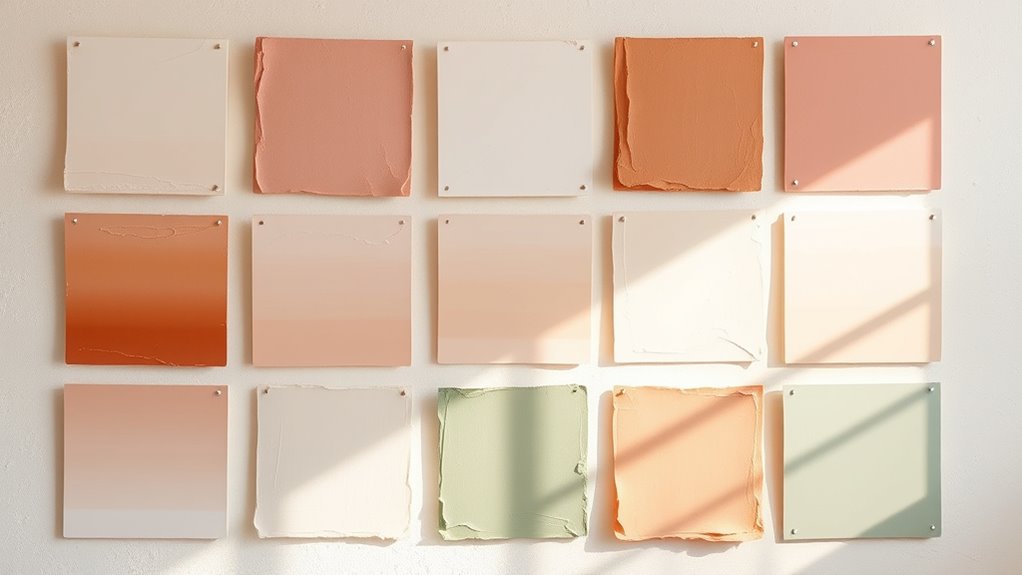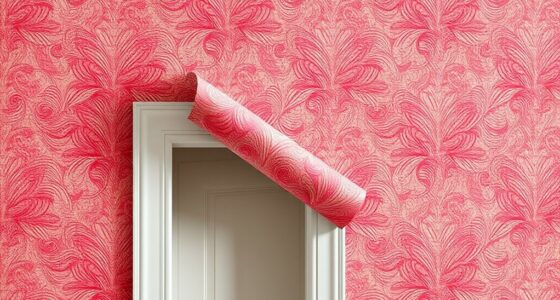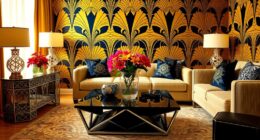To create harmonious color palettes for art and walls, understand how colors influence mood and perception. Use complementary colors for striking contrast, but sparingly, and blend analogous hues for a subtle flow. Incorporate neutrals to anchor bold shades and maintain balance. Mix colors thoughtfully by limiting primary tones and playing with accents to avoid chaos. With these principles, you’ll craft vibrant yet cohesive spaces—continue exploring to emancipate even more inspiring color combinations.
Key Takeaways
- Use complementary colors sparingly to create striking contrast without overwhelming the space.
- Incorporate neutral tones like beige or gray to anchor bold or vibrant wall colors and artworks.
- Combine analogous hues for a cohesive, subtle transition that enhances harmony in art and wall color schemes.
- Limit the number of primary colors to 3-4 and balance with neutrals for a balanced, visually appealing palette.
- Consider cultural symbolism and emotional effects of colors to evoke desired moods and ensure cohesive harmony.
Understanding Color Theory and Mood
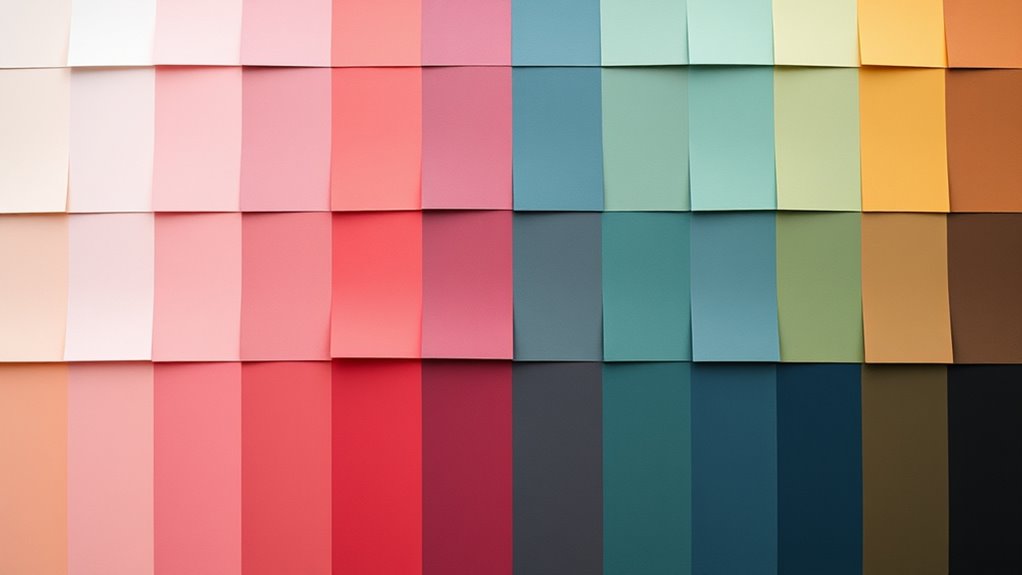
Color theory provides a foundation for understanding how different hues influence emotions and perceptions. When you explore color symbolism, you discover that specific colors often carry cultural color meanings that shape how they’re perceived across different societies. For example, red can symbolize luck in China or danger in Western cultures. Recognizing these cultural nuances helps you choose colors that evoke the right mood or message in your space. Understanding the emotional responses linked to colors allows you to create environments that feel welcoming, energetic, or calming. By grasping these connections between color symbolism and cultural color meanings, you can make more intentional choices, ensuring your color palette aligns with the feelings you want to inspire in your art or walls. Additionally, color psychology studies reveal that certain hues can influence mood and behavior, further guiding your palette decisions. Incorporating appropriate color combinations based on these principles can enhance the overall harmony and impact of your design.
Creating Balance With Complementary and Analogous Colors

To create a harmonious and visually appealing palette, balancing complementary and analogous colors is essential. Complementary colors, positioned opposite each other on the color wheel, provide striking color contrast that energizes your space or artwork. Use them sparingly to avoid overwhelming the eye. Conversely, analogous colors sit side by side, offering a more subtle, cohesive look that promotes a smooth visual flow. Combining these palettes thoughtfully helps you achieve balance—vibrancy without chaos. For example, pairing a deep blue with orange accents creates dynamic contrast, while surrounding blue with softer teal and green hues fosters unity. By carefully mixing complementary and analogous colors, you guide the viewer’s eye naturally across your space, creating an environment that feels lively yet balanced. Additionally, understanding color harmony principles helps in selecting and combining these palettes effectively to enhance your overall design. Recognizing relationship dynamics can also influence your color choices, especially if you’re aiming to evoke specific emotional responses or create particular atmospheres in your space. Incorporating balance and contrast can further refine how the colors interact and support the desired mood.
Using Neutrals to Anchor Your Palette
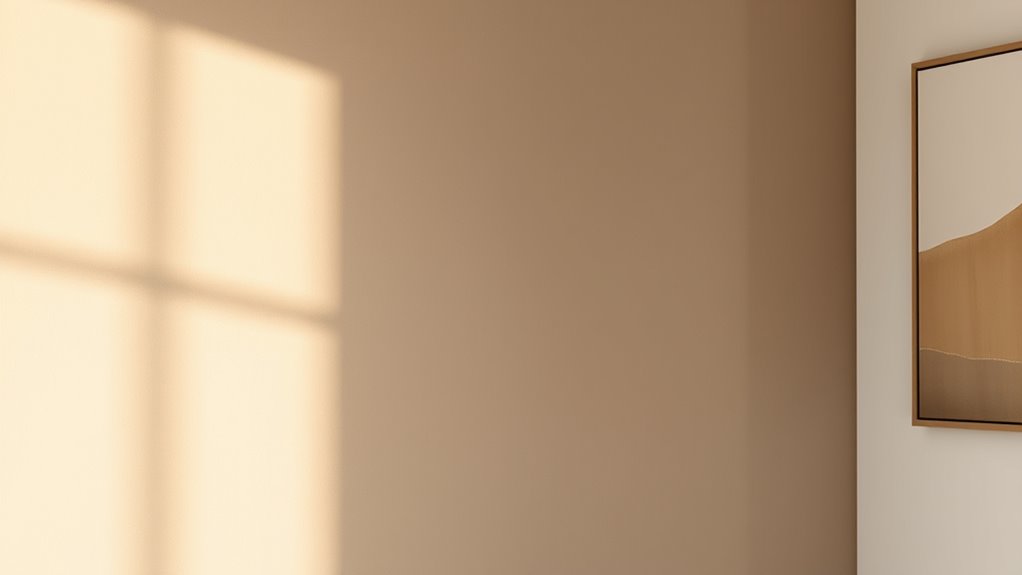
Have you considered how neutrals can serve as the foundation of your palette? Neutral tones, like beige, gray, or taupe, provide a versatile base that helps balance bold or vibrant colors. They act as a visual anchor, grounding your design and preventing it from feeling overwhelming. Using neutrals strategically creates a sense of calm and cohesion, making your artwork or walls feel harmonious. When you incorporate neutral shades, you give other colors room to stand out without clashing. Neutral tones also make your space more flexible, allowing you to easily update or change accent colors over time. Fundamentally, neutrals are your secret weapon for establishing a strong, balanced color anchoring that enhances the overall beauty of your art and walls. Additionally, layering of colors can be more effective when neutral shades serve as the backdrop, ensuring the entire palette remains cohesive. Incorporating neutrals can also help in self watering plant pots by creating a subtle, unobtrusive background that highlights the vibrant greenery or floral colors. Using environmentally friendly materials in your décor further complements this harmonious approach. Moreover, neutrals can serve as a unifying element in interior design, tying together various styles and accents for a cohesive look.
Tips for Combining Multiple Colors Effectively
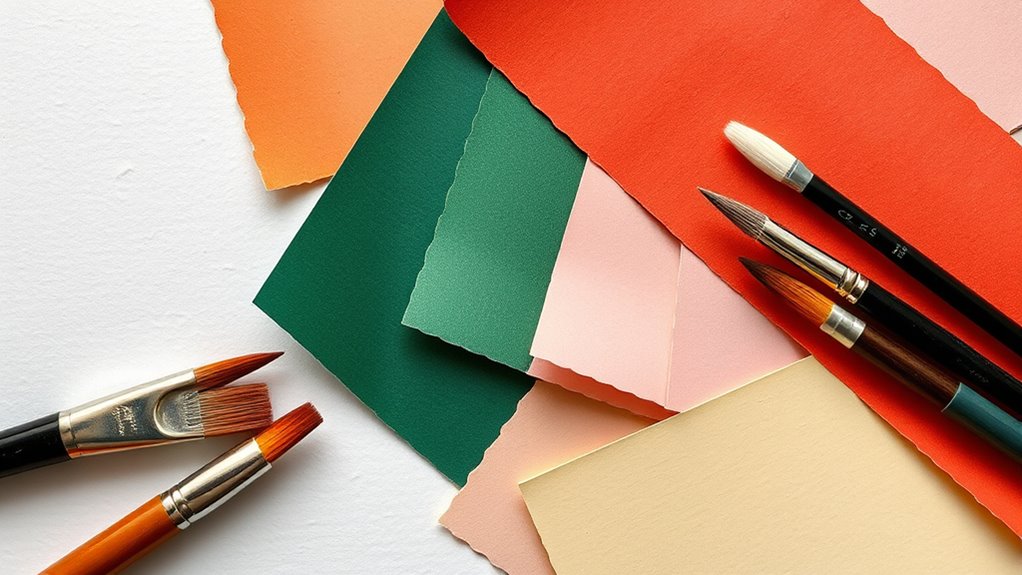
Combining multiple colors can create a vibrant and dynamic space, but it requires a thoughtful approach to avoid chaos. Start by balancing bold color contrast with more subdued shades to guide the eye naturally across the room. Embrace palette diversity by choosing colors that complement each other, rather than clash. Use a dominant hue to anchor your design, then add accent colors for interest and variety. Limit your primary palette to three or four colors to maintain harmony, and incorporate neutral tones to break up intense shades. Remember, contrast doesn’t mean clash; it’s about creating visual interest without overwhelming. By thoughtfully mixing colors and paying attention to contrast, you’ll achieve a lively yet cohesive environment that feels intentional and balanced. Additionally, understanding sound vibrations can inspire calming color choices that promote relaxation and well-being in your space, especially when considering color psychology and its influence on mood. Exploring color harmony principles can further help in selecting palettes that are naturally pleasing to the eye, creating a more cohesive and inviting atmosphere. For example, exploring zodiac sign compatibility can offer insights into harmonious color schemes that align with personal traits and preferences.
Practical Examples of Harmonized Color Schemes

Harmonized color schemes bring together different hues to create a cohesive and pleasing environment, making your space feel intentional and balanced. For example, a calming blue and soft beige combo can evoke tranquility through color psychology, perfect for bedrooms or relaxation areas. In contrast, a vibrant palette like red, yellow, and orange can energize a space, while also reflecting cultural symbolism, like warmth and celebration in certain traditions. Neutral shades paired with bold accent colors can provide sophistication and visual interest, balancing psychological effects with cultural meanings. When choosing schemes, consider how colors influence mood and what cultural associations may enhance your space’s story. Additionally, incorporating music therapy principles—such as the use of calming music—can further enhance the ambiance and emotional harmony of the environment. Understanding color psychology is essential for creating intentional spaces that resonate emotionally and culturally, leading to more harmonious environments. Incorporating cultural symbolism helps in aligning the environment with personal or cultural identity, enriching the space’s significance. Exploring color harmony techniques can also assist in selecting palettes that are visually pleasing and psychologically effective, ensuring your space feels both beautiful and balanced. These practical examples demonstrate how blending color psychology with cultural symbolism results in harmonious, meaningful environments.
Frequently Asked Questions
How Can I Test Color Combinations Before Applying Them?
You can test color combinations through digital tools like color palette generators or design apps, which let you experiment with different schemes easily. Try physical methods like printing sample swatches or painting small sections on your walls to see how colors interact in your space. Engaging in palette experimentation helps you visualize the final look, ensuring your chosen colors harmonize before committing, saving you time and avoiding costly mistakes.
What Tools Are Best for Creating Custom Color Palettes?
Think of it as painting your own masterpiece—your best tools are digital swatches and color matching tools. Programs like Adobe Color, Coolors, or Paletton let you craft custom palettes effortlessly. These tools offer real-time adjustments, harmony suggestions, and easy sharing. They help you visualize how colors work together before you commit, ensuring your art and walls harmonize perfectly, just like a painter blending shades on a canvas.
How Do Lighting Conditions Affect Color Harmony?
Lighting variability considerably impacts how colors appear and harmonize. Natural light, which varies throughout the day, can make colors look warmer or cooler, affecting your palette’s balance. Artificial lighting, like incandescent or LED, also alters color perception, sometimes creating mismatched tones. You need to contemplate both natural and artificial lighting when choosing or evaluating colors, ensuring your palette remains harmonious under different lighting conditions for consistent visual appeal.
Can Color Psychology Influence Interior Design Choices?
Yes, color psychology can influence your interior design choices. You naturally respond to color symbolism and emotional impact, which helps create the atmosphere you want. For example, using calming blues or energizing reds guides your mood and behavior. By intentionally selecting colors based on their psychological effects, you can craft spaces that evoke specific feelings, making your home more comfortable and aligned with your personal style.
How Do I Update or Change a Color Scheme Over Time?
Did you know that 60% of homeowners update their color schemes within five years? To update your palette, start with palette updating techniques like adding accent walls or new accessories to refresh the space. You can also experiment with different shades or incorporate trending colors gradually. This approach allows your color scheme to evolve naturally without overwhelming your existing decor, keeping your space stylish and harmonious over time.
Conclusion
So, now you’re a color genius, armed with all the secrets to master harmony. Just remember, blending those hues isn’t rocket science—unless you want your walls to scream or your art to scream louder. Play it safe, or go wild; either way, you’ll be the envy (or the horror) of every room. After all, who needs subtlety when you can have a kaleidoscope? Happy decorating—brace yourself for the compliments… or the chaos.
